|
|
File
Environmental Archaeological Centre, Civic Museum of Legnago – Legnago
|
Via Fermi 10 – 37045 Legnago (VR)
– Fax 0442 609735 |
  |
|
Summary
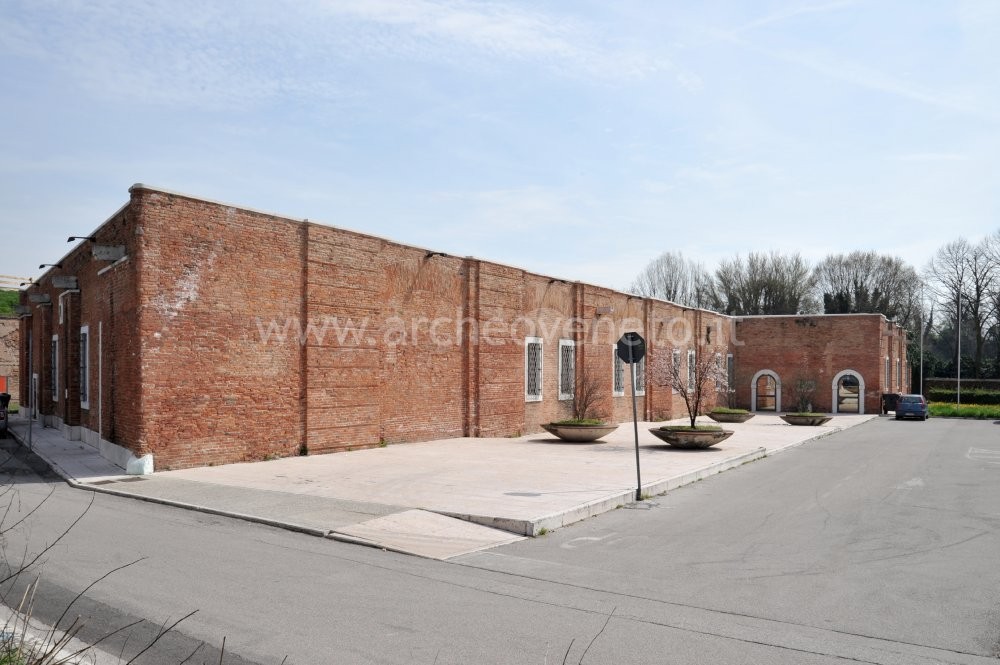
The Environmental Archaeological Centre is the most important place that collects, displays and promotes the artistic and environmental heritage of the area of Legnano. Thanks to this very central role, it manages a network of museums that includes all the museums of the Bassa Veronese (the wide plain stretching south of Verona). The importance of the Centre is further confirmed by the modernity of the building that hosts the collection, which is also equipped with efficient services for its users.
Collection history
The Environmental and Archeological Centre is located in a former Austrian military hospital, which was refurbished in 1999. It was founded by the Consorzio di Bonifica Valli Grandi e Medio Veronese (Consortium for the reclamation of the lands around Verona) with the purpose of relaunching the enhancement of the fluvial environment along the Adige river and of other minor waterways, as well as the archaeological system of the Valli Grandi Veronesi (reclaimed land between the Adige and the Po river that is rich in archaeological finds).
|

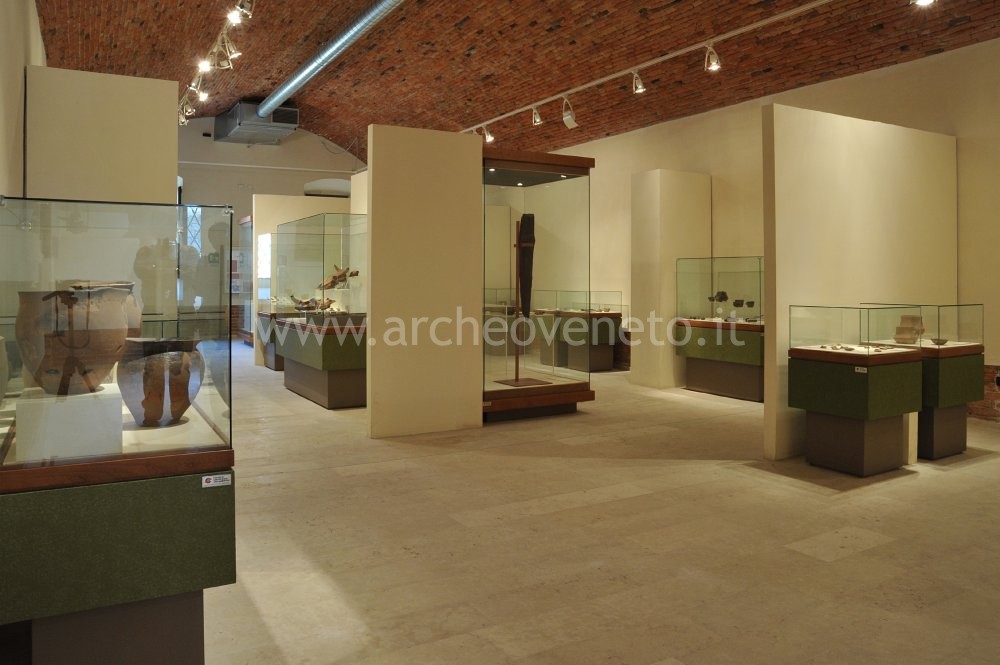 The first room contains the most ancient finds of the collection, which refer to a time span between 5000 B.C. (Neolithic) and the 13th cent. B.C. (Recent Bronze Age). The visit starts with three display cases containing numerous Neolithic tools: flint objects (scrapers, sharpened and fractured stones, cores and blades, burins and rhombs) and bone items, as well as numerous examples of ceramic materials, coming from the site of Cologna Veneta, site of Sant’Andrea. The fourth display case contains numerous fragments of square mouth vases and flint tools dating back to the Middle Neolithic (4th millennium B.C.) found in Bovolone (site Pila Culà) and in Olmo di Nogara. The following display cases contain flint tools found during the excavation of a basement hut dating back to the Copper Age and located in Gazzo Veronese (site Cristo). Numerous finds can be seen in the following display cases, which can be traced back to the Copper Age. They were found in the pile-dwelling settlements, which used to be located along the waterways, such as Canàr (San Pietro Polesine), Dossetto (Nogara), Novarina (Bovolone), Saccavezza (Bovolone), Copi Romani (Gazzo Veronese) and Tombola (Cerea). The items found in Canàr include jugs, bowls and cups of the central-European type dating back to the Early and Medium Bronze age; then there are numerous examples of ox and pig skulls, worked deer antlers, flint tools, jugs, spindle whorls, “enigmatic tablets” and some exceptional wooden finds, such as the pile of a pile-dwelling, a “pan” and the handle of an axe, which were found in Dossetto. The excavation carried out in the settlement of Novarina, which dates back to the Ancient and Middle Bronze Age, led to the discovery of numerous examples of miniature pottery, bone tools, as well as flint and polished stone objects (blades, sickle, sleekers, axes, arrowheads); then there are the tools found in Copi Romani, which include cups, antler tools and a comb decorated with a pattern reproducing the dotted face of a die dating back to the Middle Bronze Age (16th-15th cent. B.C.). The materials found in Saccavezza consist of numerous flint tools (scrapers, arrowheads, blades and sickle elements), five loom weights, four “enigmatic tablets”, some examples of pots made of utilitarian clay (bowls, cups and jugs) and pottery decorated by engraving. The first room contains the most ancient finds of the collection, which refer to a time span between 5000 B.C. (Neolithic) and the 13th cent. B.C. (Recent Bronze Age). The visit starts with three display cases containing numerous Neolithic tools: flint objects (scrapers, sharpened and fractured stones, cores and blades, burins and rhombs) and bone items, as well as numerous examples of ceramic materials, coming from the site of Cologna Veneta, site of Sant’Andrea. The fourth display case contains numerous fragments of square mouth vases and flint tools dating back to the Middle Neolithic (4th millennium B.C.) found in Bovolone (site Pila Culà) and in Olmo di Nogara. The following display cases contain flint tools found during the excavation of a basement hut dating back to the Copper Age and located in Gazzo Veronese (site Cristo). Numerous finds can be seen in the following display cases, which can be traced back to the Copper Age. They were found in the pile-dwelling settlements, which used to be located along the waterways, such as Canàr (San Pietro Polesine), Dossetto (Nogara), Novarina (Bovolone), Saccavezza (Bovolone), Copi Romani (Gazzo Veronese) and Tombola (Cerea). The items found in Canàr include jugs, bowls and cups of the central-European type dating back to the Early and Medium Bronze age; then there are numerous examples of ox and pig skulls, worked deer antlers, flint tools, jugs, spindle whorls, “enigmatic tablets” and some exceptional wooden finds, such as the pile of a pile-dwelling, a “pan” and the handle of an axe, which were found in Dossetto. The excavation carried out in the settlement of Novarina, which dates back to the Ancient and Middle Bronze Age, led to the discovery of numerous examples of miniature pottery, bone tools, as well as flint and polished stone objects (blades, sickle, sleekers, axes, arrowheads); then there are the tools found in Copi Romani, which include cups, antler tools and a comb decorated with a pattern reproducing the dotted face of a die dating back to the Middle Bronze Age (16th-15th cent. B.C.). The materials found in Saccavezza consist of numerous flint tools (scrapers, arrowheads, blades and sickle elements), five loom weights, four “enigmatic tablets”, some examples of pots made of utilitarian clay (bowls, cups and jugs) and pottery decorated by engraving.
Finally, the items discovered in the settlement of Tombola include numerous bone tools (combs, pins) and bronze tools (awls, pins, a dagger and a knife), as well as a wooden board and ceramic vases.
The last part of the room is devoted to the so called “Didactic island”, where some of the handicraft activities typical of the Bronze Age, such as bone and antler working and the bronze fusion, are analyzed.
|

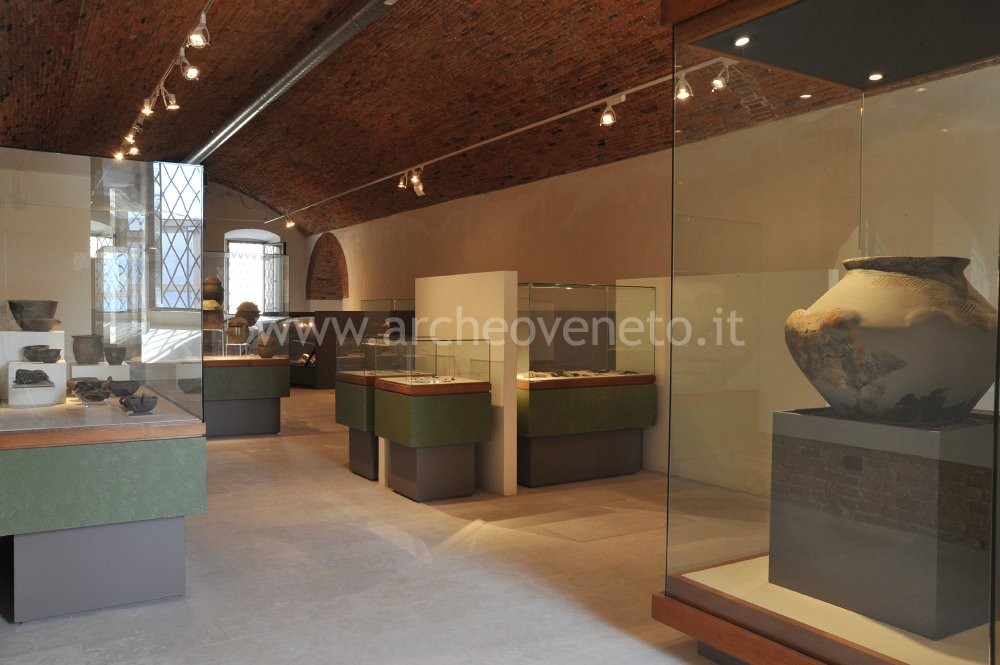 The second room contains items dating back to the Middle and Recent Bronze Age, found in the necropolises of the low plain of Verona, in particular in the sites of Olmo (Nogara), Scalvinetto (Legnago), Castello (Cerea), Franzine Nuove (Villa Bartolomea) and Crosare (Bovolone). The objects found in Olmo include numerous ornamental objects (a necklace, pendants, bronze studs, pins used to hold pleats and hourglass-shaped pins), a remarkable amount of bronze swords and daggers, four male and female skeletons buried with their grave goods and the intentional burial of an ox. The finds discovered in the necropolis of Scalvinetto are mainly cinerary urns, provided with grave goods, which bear witness to the hypothesis that the most common funerary rite was incineration. The same practice was adopted in the necropolis of Castello; the case containing the finds discovered in this site displays a cinerary urn, and next to it a tintinnabulum and two bronze ponytail holders that were found at the sides of the skull. The archaeological finds discovered in Franzine Nuove prove that in this site both funerary rites were practiced. The second room contains items dating back to the Middle and Recent Bronze Age, found in the necropolises of the low plain of Verona, in particular in the sites of Olmo (Nogara), Scalvinetto (Legnago), Castello (Cerea), Franzine Nuove (Villa Bartolomea) and Crosare (Bovolone). The objects found in Olmo include numerous ornamental objects (a necklace, pendants, bronze studs, pins used to hold pleats and hourglass-shaped pins), a remarkable amount of bronze swords and daggers, four male and female skeletons buried with their grave goods and the intentional burial of an ox. The finds discovered in the necropolis of Scalvinetto are mainly cinerary urns, provided with grave goods, which bear witness to the hypothesis that the most common funerary rite was incineration. The same practice was adopted in the necropolis of Castello; the case containing the finds discovered in this site displays a cinerary urn, and next to it a tintinnabulum and two bronze ponytail holders that were found at the sides of the skull. The archaeological finds discovered in Franzine Nuove prove that in this site both funerary rites were practiced.
The second part of the room is devoted to the Terramare settlements, characterized by dwellings surrounded by an earthwork strengthened on the inside by buttresses, and encircled by a wide moat supplied with running water, called “embanked” villages. Traces of these settlements, which characterized the plain of Verona between the 14th and 13th cent. B.C. have been identified in Scalvinetto, Olmo di Nogara, Terranegra, Bovara, Fabbrica dei Soci, Crosare, Corte Lazise, Castello and Fondo Paviani. The archaeological materials found in this sites prove how widespread the network of commercial contacts was at the time. The display cases contain numerous ornamental objects (pins, rings, armillae, pendants, necklaces), among which particularly noteworthy are two amber beads of the Tiryns type, numerous bronze tools (daggers, fragments of swords, razors, a sickle, chisels, moulds), as well as fragments of non local pottery (Mycenean and Apennine) and tools in worked bone and antler (handles of knives and awls).
|

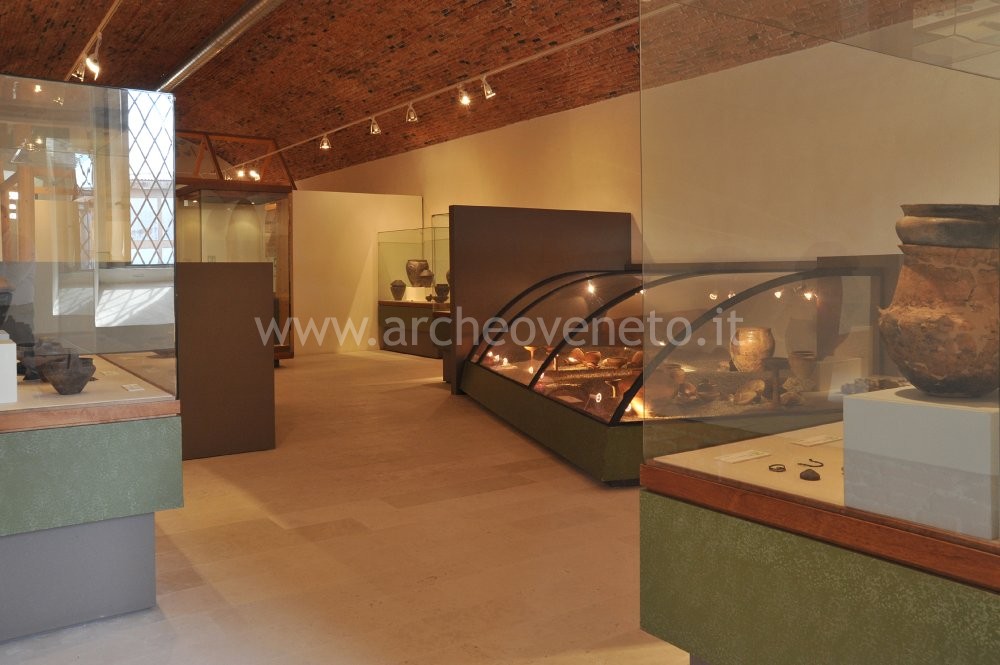 The third room is devoted to the Venetian necropolises and settlements in the Iron Age (10th- 6th cent. B.C.) discovered in the area of the Veronese plain near Legnago. The first section of the room is totally devoted to the necropolis of Colombara (Gazzo Veronese). In this site numerous cinerary urns were found, either biconical (9th-8th cent. B.C.) or situlate (7th-6th cent. B.C.), containing burnt bones and numerous ornamental objects: bronze fibulae, bracelets, rings, pins, armillae, pendants, tintinnabula, spindle whorls, reels, anklebones, bowls and cups, a belt hook and an extraordinary dagger with decorated scabbard and studded handle. A display case shows the different funerary practices adopted by the ancient Venetian people and in particular in this area: a burial in pit accompanied by rich grave goods, burial in a dolium (burial jar) and the grave of a woman associated with the remains of a horse. The three following display cases contain the grave goods of the necropolis of Lovara (7th cent. B.C.); the items displayed include situlate fictile urns with covering bowls, armillae, spindle whorls and pins. Particularly noteworthy are the grave goods of an infant, possibly female, consisting of an urn and its cover, as well as a swan egg accompanied by shells and numerous ornamental objects. The third room is devoted to the Venetian necropolises and settlements in the Iron Age (10th- 6th cent. B.C.) discovered in the area of the Veronese plain near Legnago. The first section of the room is totally devoted to the necropolis of Colombara (Gazzo Veronese). In this site numerous cinerary urns were found, either biconical (9th-8th cent. B.C.) or situlate (7th-6th cent. B.C.), containing burnt bones and numerous ornamental objects: bronze fibulae, bracelets, rings, pins, armillae, pendants, tintinnabula, spindle whorls, reels, anklebones, bowls and cups, a belt hook and an extraordinary dagger with decorated scabbard and studded handle. A display case shows the different funerary practices adopted by the ancient Venetian people and in particular in this area: a burial in pit accompanied by rich grave goods, burial in a dolium (burial jar) and the grave of a woman associated with the remains of a horse. The three following display cases contain the grave goods of the necropolis of Lovara (7th cent. B.C.); the items displayed include situlate fictile urns with covering bowls, armillae, spindle whorls and pins. Particularly noteworthy are the grave goods of an infant, possibly female, consisting of an urn and its cover, as well as a swan egg accompanied by shells and numerous ornamental objects.
The second part of the room is devoted to the dwellings that characterized the area surrounding Verona in the early Iron Age (8th – 6th cent. B.C.). The site chosen as model has been Terranegra (Legnago), where numerous bronze finds have been discovered, which include a decorated shovel, a fragmented belt hook, pins used to hold pleats and a bracelet, together with glass beads, numerous bone and horn tools (a needle, tool handles, pierced and smoothed bones used for manufacturing objects), the main tools used in the weaving and spinning activities (loom weights, reels, spindle whorls and combs) and a remarkable amount of ceramic vases (unpurified, grey and decorated with red and black stripes clay). The discovery of these items has provided important information on the activities carried out by the people that have inhabited these settlements since the early Iron Age. Particularly noteworthy is also the reconstruction of the floor of the fireside of a hut located in the ancient settlement of Terranegra.
|

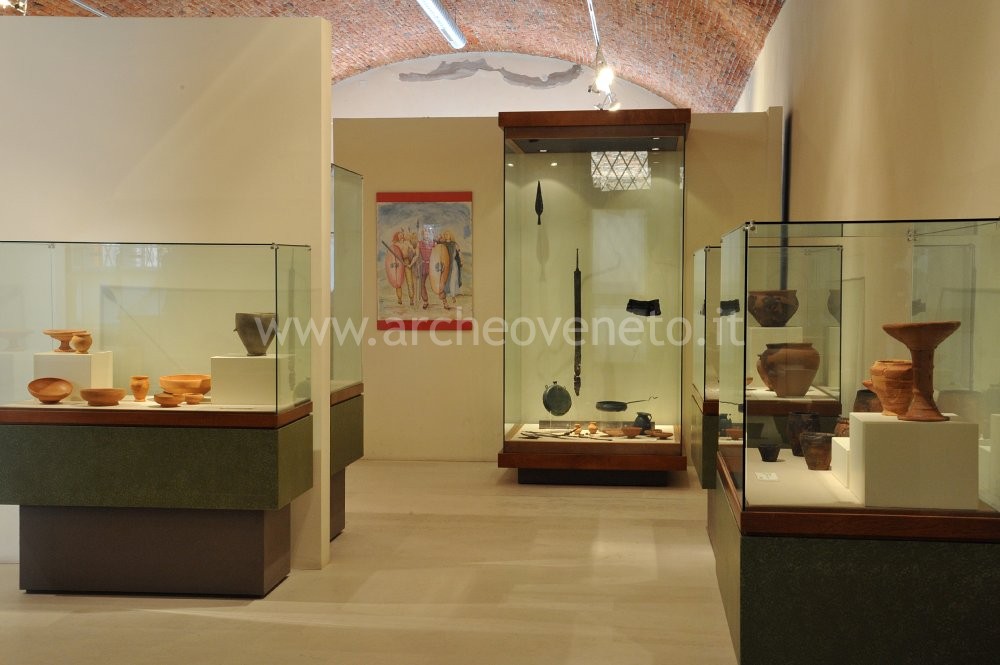 The visit to the museum goes on with the exhibition of grave goods and other archaeological finds coming from different necropolises of the early Iron Age (6th-5th cent. B.C.) located in Oppeano (Fondo Gambin, Franchine and Belgioioso) and Gazzo Veronese (Dosso del Pol). Numerous bronze items were found in the necropolis of Fondo Gambin, including a diamond-shaped belt, a few fragments of situla and some belt plates. The display case, containing the material found in Fondo Gambin, shows also a fragment of the important red figure kylix (drinking cup) manufactured by the workshop of the Pentesilea Painter (450-400 B.C.), which was found in the settlement of Montara (Oppeano). The visit to the museum goes on with the exhibition of grave goods and other archaeological finds coming from different necropolises of the early Iron Age (6th-5th cent. B.C.) located in Oppeano (Fondo Gambin, Franchine and Belgioioso) and Gazzo Veronese (Dosso del Pol). Numerous bronze items were found in the necropolis of Fondo Gambin, including a diamond-shaped belt, a few fragments of situla and some belt plates. The display case, containing the material found in Fondo Gambin, shows also a fragment of the important red figure kylix (drinking cup) manufactured by the workshop of the Pentesilea Painter (450-400 B.C.), which was found in the settlement of Montara (Oppeano).
The two following display cases contain objects discovered in the necropolis of Franchine; they include numerous bronze items that were part of grave goods (a single handled cup, fibulae and a bended dagger), a few cinerary urns and a bronze cist (casket).
The excavation carried out in the necropolis of Dosso del Pol has dug up numerous ornamental objects and items of clothing (pendants, Certosa fibulae, the hook of a large belt, a decorated diamond-shaped belt and beads of a necklace), a tripod and a ribbed cist in bronze foil, as well as numerous examples of ash grey pottery and vases of Etruscan origin and from the Po valley, which bear witness to the wide-spread trade network, in which the centre of Gazzo Veronese took part. The second part of the room is devoted to two cemeteries dating back to the late Iron age (2nd-1st cent. B.C.): the necropolis of Casalandri (Isola Rizza) and the one in Lazisetta (Santa Maria di Zevio). The room also displays a detailed description of the Celtic peoples, who reached the plain of Verona during the Romanization period, and some grave goods dating back to this time. Two of them are particularly noteworthy: one belonging to a male burial of a Celtic warrior (unpurified clay, fibulae, intentionally folded weapons, pans, bronze pottery and a shield boss) and a female burial (different kinds of pottery, bronze pots with decorated handle, blades and numerous ornamental objects). The last part of the room is devoted to the reconstruction of three graves: one is delimited by large river pebbles, one is just laid in a pit and the last one is placed in a box made of bricks.
|
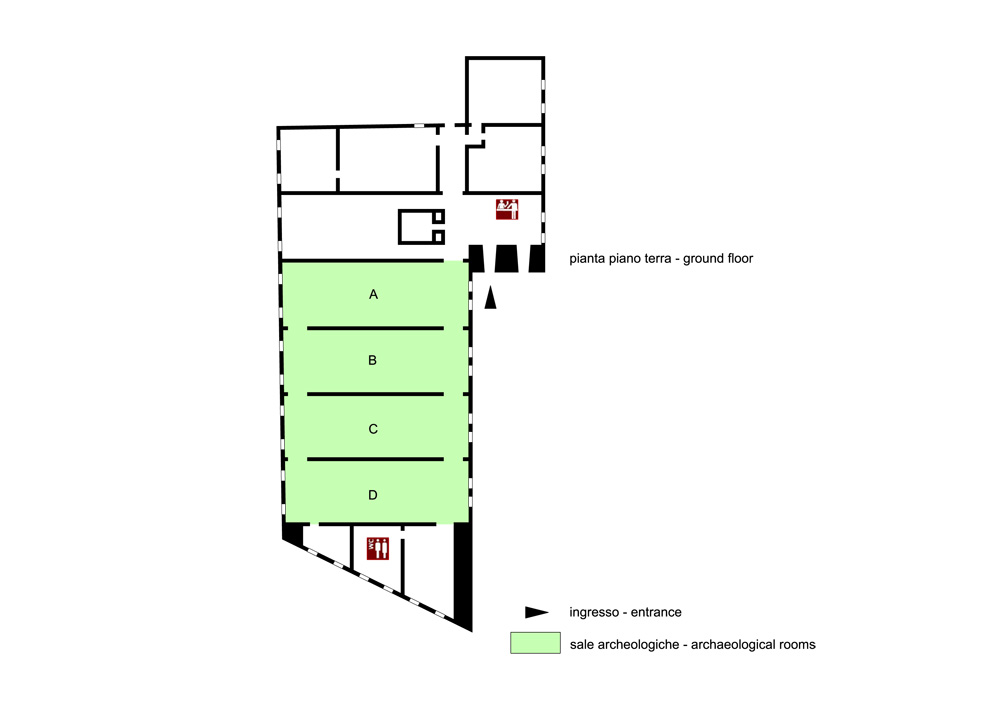
Admission: Negli orari di apertura
Ticket: Si
Price: Full fare: 2.50 €; Reduced fare: 1 €
 School access School access
 Disabled access Disabled access
Opening Days
| Tipology |
When |
Specs |
| Summer |
Monday |
9.00 – 13.00 e 15.00 – 18.30 |
| Summer |
Tuesday |
9.00 – 13.00 e 15.00 – 18.30 |
| Summer |
Wednesday |
9.00 – 13.00 e 15.00 – 18.30 |
| Summer |
Thursday |
9.00 – 13.00 e 15.00 – 18.30 |
| Summer |
Friday |
9.00 – 13.00 e 15.00 – 18.30 |
| Summer |
Sunday |
16.00 – 19.00 |
| Winter |
Monday |
9.00 – 13.00 e 15.00 – 18.30 |
| Winter |
Tuesday |
9.00 – 13.00 e 15.00 – 18.30 |
| Winter |
Wednesday |
9.00 – 13.00 e 15.00 – 18.30 |
| Winter |
Thursday |
9.00 – 13.00 e 15.00 – 18.30 |
| Winter |
Friday |
9.00 – 13.00 e 15.00 – 18.30 |
| Winter |
Sunday |
15.00 – 18.00 |
Recommended tour time (minutes): 60
 Toilet Toilet
 Parking Parking
 Bookshop Bookshop
 Rest points Rest points
 Bar/Resaturant Bar/Resaturant
 Brochure Brochure
Italian
 Captions under exhibits Captions under exhibits
Italian
 PC learning points PC learning points
Computer room
 Guided Tours Guided Tours
 Educational activities Educational activities
 Educational workshops Educational workshops
 Library and documentation centre Library and documentation centre
 Other activities Other activities
Conference hall
| Dalla terra al Museo. Mostra di reperti preistorici e protostorici degli ultimi dieci anni di ricerca dal territorio veronese 1996, a cura di Belluzzo G., Salzani L. , Legnago. |
| Musei e raccolte archeologiche del Veneto 2004, a cura di Di Mauro A., Dosson di Casier, pp. 127-128. |
| Bonetto J. 2009, Veneto (Archeologia delle Regioni d’Italia), Roma, pp. 363-364. |
|

